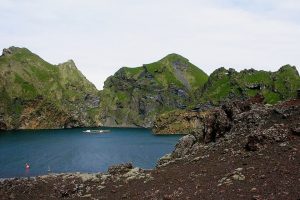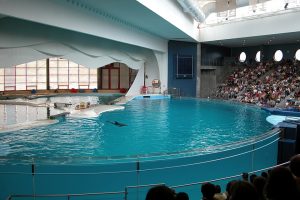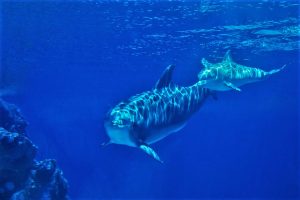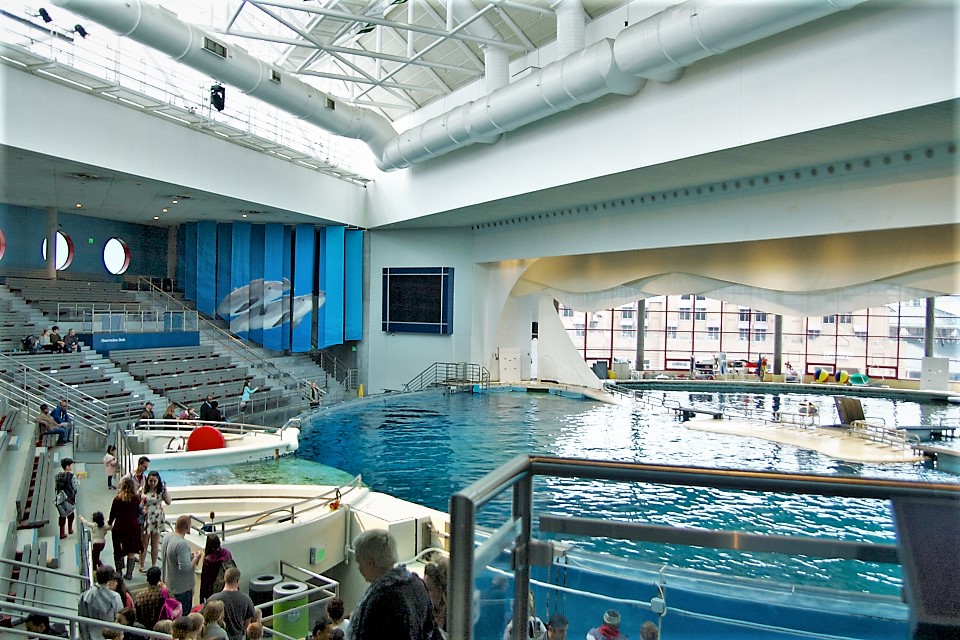Exclusively for zoos.media – 06/27/2023. Author: Philipp J. Kroiss
The new statement of the National Aquarium in Baltimore concerning their dolphin sanctuary, which is a nice name for some net cages, exposes an inhumane and ignorant agenda.
“Dolphin Sanctuary”: How National Aquarium demasks itself
Experts, as well as friends of dolphins, are outraged by the latest statement of the National Aquarium, also called Baltimore Aquarium, concerning their net cage husbandry which they euphemistically call “sanctuary”. If you look at it, it’s pretty much exposing their agenda it shows that this move has got nothing to do with animal welfare, conservation, or what else National Aquarium claims to stand for. The whole statement is a disgrace.
All about public opinion
“Knowing that the momentum of public opinion was in our favor, we set out to establish the guiding principles, practices and, not least of all, the proper place for our sanctuary.” – National Aquarium (Baltimoire, USA)
After reproducing animal rights activists’ propaganda concerning dolphin husbandry bans threatening the conservation of cetaceans, National Aquarium talks about a public opinion. Interestingly, the statement ignores, for example, the International Union for Conservation of Nature (IUCN). Instead, it considers public opinion, which they think exists, to be more important. In IUCN’s One Plan Approach to Conservation, it is made clear that comprehensive conservation can only exist by taking action in situ and ex situ. If you really are a conservationist, you take the IUCN much more important that a made-up public opinion.
More than 150 researchers, scientists, and other experts signed a statement emphasizing the importance of marine mammal husbandry. It’s not understandable how an institution claiming to care for science, conservation, and animal welfare, could ignore it. Disregarding these experts’ statement founded on facts is impossible for management guided by the animals’ and nature’s best interests. It weighs much more than some corrupt governments making wrong decisions. Well, at least for people caring for facts instead of a public opinion that is not supported by data. Millions of people visit properly managed dolphinariums every year because they care for the truth.
Questionable Relationships
“[Our work] led us to forge a relationship with the experts at SEA LIFE Trust, a British organization mirroring our efforts with a focus on beluga whales, and the Whale Sanctuary Project, another whale-focused sanctuary project based in Canada.” – National Aquarium (Baltimoire, USA)

Not one of these projects is either working or focused on bottlenose dolphins. The Whale Sanctuary Project has not even an existing facility. The Sea Life Trust is failing on and on again to make their net cage husbandry work. Again, the two beluga females – one male was lost in the process already in China – are back in their small holding facility on land. Claiming these organizations would be experts in making such a project work, is ridiculous. Both projects are greenwashed by the animal rights industry. This industry wants places like National Aquarium to close.
So, how should these organizations be able to help if they don’t get their own projects working? It’s not possible. Furthermore, it’s massively ridiculous when National Aquarium claims: “[W]e looked within our industry to learn from the progress made in other places”. There is no significant progress – at least if you don’t call constantly failing a progress. In addition, both projects are not part of the world of zoos and aquariums. They have no accreditation or certification of worth. So, if this is the National Aquarium’s “industry”, this facility apparently left the world of properly managed animal care facilities focused on conservation, education, and research.
Animal Cruelty
So, the following quote in the statement might not have hit readers by surprise. In this, National Aquarium embraces an HSUS-surrogate organization that is known for greenwashing animal cruelty in facilities managed by animal rights activists and organizations:
“We worked with these partners to establish guidelines for marine mammal sanctuaries that were then submitted to the Global Federation of Animal Sanctuaries (GFAS), the only globally recognized organization providing standards for identifying legitimate animal sanctuaries.” – National Aquarium (Baltimoire, USA)
The GFAS is known for covering up its “own” bad husbandry with anti-zoo propaganda. The “sanctuaries” accredited by them, are known for mistreating chimpanzees and elephants, for example. The basic standard of the GFAS makes important basic needs of animals impossible to fulfill. Breeding is one example. GFAS forces its so-called sanctuaries to stop breeding. For dolphins, it’s important to breed because breeding is the basis of the natural development of social group constellation. In addition, constantly medically preventing breeding poses a health danger for the animals. There is simply no medication for that. All medications existing are only for short-term contraception.
Proud of what?
“[W]e’re incredibly proud of our work with our partners SEA LIFE Trust and the Whale Sanctuary Project, as well as our collaboration with GFAS, to develop the world’s defining standards for cetacean sanctuaries.” – National Aquarium President and CEO John Racanelli

So, someone is proud of partnering with not-working projects and an organization greenwashing animal cruelty. Someone else could argue that a body that is proud of that cannot be trusted by saying animal welfare would be a top priority. In the end, this is a partnership with the animal rights industry spreading lies and misinformation while failing to provide a better alternative. This industry never saved a species and is not in the lead of conservation.
If this is the National Aquariums’ “industry” and the organization is a “proud” partner, it left the way of becoming a better zoological facility and optimizing its care for dolphins in order to do a marketing stunt. Wasting “3,940 hours of poolside dolphin training sessions” for an “eventual transition to sanctuary life” steals researchers important hours for doing their job. An important job the National Aquarium apparently stopped to care about: the conservation of decreasing dolphin populations. Luckily, this is done successfully by zoos and aquariums really caring for the well-being of dolphins all over the world.
Real experts disagree
The National Aquarium’s sanctuary project is criticized by many experts in the world of dolphinariums publically and internally. Of course, National Aquarium’s statement doesn’t mention that. In contrast, it claims that ten other dolphin-holding institutions contacted them. For what? Get bad husbandry greenwashed in the aquariums’ planned net cages? No trustworthy dolphinarium would do that. The scientist and researcher Dr. Jason Bruck leads a lab focused on researching dolphins. It published a statement:
“[I]t is not for the National Aquarium or any other sanctuary organization to market themselves as experts in sea pen housing to any organization (including Global Federation of Animal Sanctuaries (GFAS)). As it stands the development of guidelines for cetacean sanctuaries is premature as neither the Dolphin Project, Sea Life Trust, Whale Sanctuary Project or National Aquarium have successfully housed animals long-term in ‘sanctuaries’. Any organization that takes these groups’ recommendations as part of guidelines for this experimental form of activist animal management should not be taken seriously.” – Bruck Lab
Furthermore, it is explained that “we are starting to see evidence from Sea Life Trust and The Dolphin Project that this way of housing animals does not meet minimum welfare standards”. Bruck Lab recommends collecting data first and “consider the possibility that cetaceans do not necessarily all do equally well in the housing proposed by these groups”. The optimism concerning the plan is very limited, to say the least: “This is a more prudent plan than raising impossible expectations in the public and among donors.”
Plan demasked

In the end, its plan as well as the whole statement demask the National Aquarium’s agenda. For National Aquarium, cooperation with failing organizations is obviously more important than cooperation with zoos and aquariums with the aim of animal welfare, conservation, and science. They never made it clearer before. That should be a wake-up call – especially for bodies still accrediting or certifying this facility. It’s not excusable anymore to not see the facts. It is impossible to ignore. So, it will be interesting and important how the world of zoos and aquariums will respond to it.
In recent years, opportunism concerning animal rights organizations become a trend in the United States. Associations as well as individual facilities try to appease activists by caving into their demands. This strategy never worked. Ironically, the opportunist parties only strengthen a movement that aims to destroy them. The victims of this strategy are primarily the animals. They are put in bad husbandry. The greenwashing of their suffering doesn’t make this animal cruelty inexistent. So, in the end, opportunism exposes the zoo and aquarium responsibles who care more for some marketing options than animal welfare.
For the sake and welfare of the animals, it’s important to stop this opportunism. In the end, animal rights organizations oppose comprehensive conservation. It’s impossible to implement their concept of animal rights and have animals in human care. These “sanctuaries” are just a greenwashed but cruel way to get rid of animals. They don’t benefit conservation at all. In a good zoo, everything is about conservation. So, there is no common ground between the animal rights industry’s so-called sanctuaries and trustworthy zoos and aquariums.
